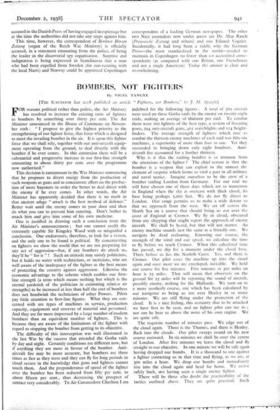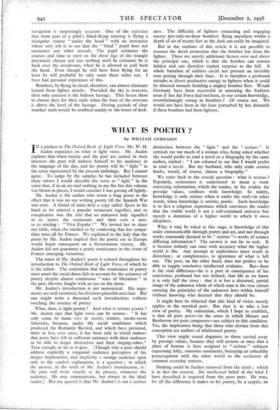BOMBERS, NOT FIGHTERS
By NIGEL TANGYE
[THE S?ECTATOR last week published an article " Fighters, not Bombers," by j. 1b1. Spaightl This decision is tantamount to the War Minister announcing that he proposes to divert energy from the production of such weapons as guns and to concentrate effort on the produc- tion of more bayonets in order the better to deal direct with the enemy if he ever comes. In other words, the Air Minister has apparently_ decided that there is no truth in that ancient adage " attack is the best method of defence." Better wait until the enemy comes to your door and then do what you can to prevent him entering. Don't bother to attack him and give him some of his own medicine.
One is justified in drawing such a conclusion from the Air Minister's announcement ; but one cannot credit the extremely capable Sir Kingsley Wood with so misguided a conclusion. One endeavours, therefore, to look for a reason, and the only one to be found is political. By concentrating on fighters we show the world that we are not preparing for any act of aggression—but, if any bombers do attack us, they'll be " for it " ! Such an attitude may satisfy politicians, but it holds no water with technicians, or tacticians, who are well aware of the inadequacy of the fighter as the best means of protecting the country against aggression. Likewise the economic advantage to the scheme which enables our first- line strength (a term which means nothing but which is the eternal yardstick of the politician in estimating relative air strengths) to be increased at less than half the cost of bombers does not hoodwink the technicians of other Powers. Pilots par little attention to first-line figures. What they are con- cerned with are types of machines in service, production capacity, equipment and reserves of material and personnel. And they are far more impressed by a large number of modern bombers than an equivalent number of fighters. This is because they are aware of the limitations of the fighter with regard to stopping the bomber from getting to its objective.
The difficulty of this interception was well illustrated in the last War by the success that attended the Gotha raids by day and night. Certainly conditions are different now, but if anything they are more in favour of the bomber. Anti- aircraft fire may be more accurate, but bombers are three times as fast as they were and they can fly for long periods in cloud secure in the knainfledge that guns and fighters cannot touch them. And the preponderance of speed of the fighter over the bomber has been reduced from fifty per cent. to about fifteen per cent., thus decreasing the prospect of contact very considerably. To Air Commodore Charlton I am indebted for the following figures : A total of 369 aircraft were used on these Gotha raids by the enemy on twenty-eight raids, making an average of. thirteen per raid. To combat them were 200 fighters of the best type, a system of listening posts, 294 anti-aircraft guns, 415 searchlights and 114 height- finders. The average strength of fighters which rose to combat the thirteen enemy machines of each raid was fifty-six machines, a superiority of more than four to one. Yet they succeeded in bringing down only eight bombers. Anti- aircraft fire accounted for a further thirteen.
Why is it that the raiding bomber is so immune from the attentions of the fighter ? The chief reason is that the bomber is a weapon that can .exploit to the utmost the element of surprise which forms so vital a part in all military and naval tactics. Imagine ourselves to be the crew of a bomber raiding London from Germany. For our raid we will have chosen one of those days which are so numerous in England when the sky is overcast with thick cloud, its base being perhaps 5,00o feet. We do not fly direct to London. Our range permits us to make a wide detour so that we approach from the west. We set off across the North Sea on a course that should bring us out over the coast of England at Cromer. We fly in cloud, obscured from any shipping that might report the approach of enemy aircraft. We shall be heard, but that will not matter. An enemy machine sounds just the same as a friendly one. We navigate by dead reckoning. Knowing our course, the strength of the wind and our speed, we calculate the time to fly before we reach Cromer. When this calculated time has passed, we dip for a moment under the cloud base.
There before us lies the Norfolk Coast. Yes, and there is Cromer. Our pilot eases the machine up into the cloud again and once more we arc enveloped, invisible. We hold our course for five minutes. Five minutes at 30o miles an hour is 25 miles. That will mean that observers on the ground for 25 miles will be reporting the sound of aircraft, possibly enemy, making for the Midlands. We turn on to a more southerly course, one which has been calculated by our navigator to bring us out over Henley in so many minutes. We are still flying under the protection of the cloud. It is a nice feeling, this certainty that to be attacked we have first to be seen, and no fighter pilot can see us -; nor can he hear us above the noise of his own engine. We are quite safe.
The requisite number of minutes pass. We edge out of the cloud again. There is the Thames, and there is Henley.
Back into the clouds. Our pilot sweeps round on his new course eastward. In six minutes we shall be over the centre of London. After five minutes we leave the cloud and fly straight to our objective. In one minute we will be safe again having dropped our bombs. It is a thousand to one against a .fighter contacting us in that time and flying, as we are, at 3oo miles a hour. We drop our bombs and immediately rise into the cloud again and head for home. We arrive safely back, not having seen a single enemy fighter. There will be those who doubt the practicability of the tactics outlined above. They are quite practical. Such navigation is surprisingly accurate. One of the exercises that form part of a pilot's blind-flying training is flying a triangular course " under the hood " with an instructor whose only job is to see that the " blind " pupil does not encounter any other aircraft. The pupil estimates the courses and time to steer on the three legs of the triangle previously chosen and sees nothing until he estimates he is back over the aerodrome, when he is allowed to pull back the hood. Even though he will have been flying for an hour he will probably be only some three miles out. I have had personal experience of this.
Bombers, by flying in cloud, therefore, can almost eliminate hazard from fighter attacks. Provided the sky is overcast, their only concern is the balloon barrage. This forces them to choose days for their raids when the base of the overcast is above the level of the barrage. During periods of clear weather raids would be confined mainly to the hours of dark- ness. The difficulty of fighters contacting and engaging enemy Soo-mile-an-hour bombers flying anywhere within a depth of air of 20,000 feet in the dark can easily be imagined.
But in the confines of this article it is not possible to recount the detail protection that the bomber has from the fighter. These are merely additional factors over and above the principal one, which is that the bomber can remain hidden and can therefore exploit surprise to the full. A whole battalion of soldiers could not prevent an invisible man getting through their lines. It is therefore a profound mistake to divert productive energy to fighters when it could be directed towards building a mighty bomber fleet. Would Germany have been successful in annexing the Sudeten areas if her Air Force had not been, to our certain knowledge, overwhelmingly strong in bombers ? Of course not. We would not have been in the least perturbed by her demands if those bombers had been fighters.



























































 Previous page
Previous page